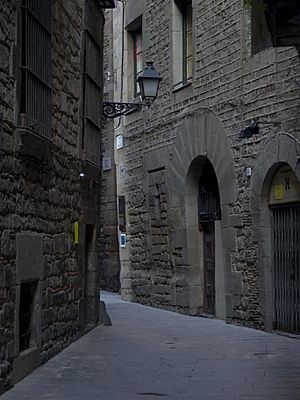Jewish quarter (Barcelona) facts for kids
The Jewish Quarter of Barcelona (called El Call in Catalan) is a special old part of Barcelona, Spain. You can find it in the Gothic Quarter. For many centuries, from the 600s to the 1300s, this area was the main home for Barcelona's Jewish community. It was one of the most important Jewish areas in all of Spain and Portugal during the Middle Ages.
Contents
What Does 'El Call' Mean?
The name El Call comes from the Catalan language. It means 'little street' or 'alley'. This name described the narrow streets where Jewish people lived. The whole Jewish community that governed itself was called an aljama.
A Look Back: History of the Call
How the Jewish Quarter Began
Jewish people started arriving in Barcelona after the year 70 CE. They were part of many groups moving to Europe to escape problems in their homeland. By the year 1079, about 70 Jewish families lived in Barcelona.
By the end of the 600s, the Jewish population lived together in the Call. This area grew around streets like Carrer del Call, Carrer de Sant Domènec del Call, Carrer Marlet, and Arc de Sant Ramón del Call.
Growing Strong: The Golden Age (1100s-1200s)
The Jewish Quarter grew a lot in the 12th and 13th centuries. More Jewish people arrived, including some who had to leave France. Because of this growth, a new area called the Call Menor (Minor Call) was created. The older part became known as the Call Major (Major Call).
By the 1200s, the Call was the largest Jewish community in Catalonia. During its best times, about 15% of Barcelona's people were Jewish. Most of the 4,000 Jewish residents lived in the Jewish Quarter. Barcelona became known as a "city of wise people" among Jews.
Jewish people worked as doctors, scientists, merchants, and even lent money to the rich families of Catalonia. Since only Jews could legally lend money, they became important bankers for the rulers of Catalonia. They were officially protected by the king.
In 1215, a church meeting suggested that Jews should wear special clothes to identify themselves. However, by 1268, King James I removed this rule for the Jews in Barcelona.
Tough Times: Challenges and Changes (1300s-1400s)
Life for Jewish people in Barcelona became harder in the 1300s. The city faced difficult times with famines starting in 1333. Then, the Black Death arrived in 1348, which was a terrible sickness that killed many people. About one-fifth of Barcelona's population died.
Sadly, many people blamed the Jewish community for these problems. This led to an attack on the Jewish Quarter in 1349.
The Jewish Quarter was almost completely destroyed during a wave of violence in 1391. From August 5 to August 10, about 300 Jewish people were killed. This event greatly reduced the Jewish population in Barcelona.
Later, during the Spanish Inquisition, the Jewish community in Barcelona became very small. King Ferdinand even ordered that synagogues (Jewish places of worship) could not be larger than the smallest Christian church.
The Jewish Quarter Today
In the heart of the old Jewish Quarter, you can find the Ancient Synagogue. It is also called the Sinagoga Major. This synagogue is believed to be one of the oldest in Europe, possibly existing since the 400s.
In the 1990s, the synagogue was carefully restored. It reopened to visitors in 2003, allowing people to learn about its long history.
Jewish Community in Barcelona Now
Today, about 3,500 Jewish people live in Barcelona. This makes it the largest group of Jewish residents in Spain.
Images for kids
See also
 In Spanish: Barrio judío de Barcelona para niños
In Spanish: Barrio judío de Barcelona para niños



